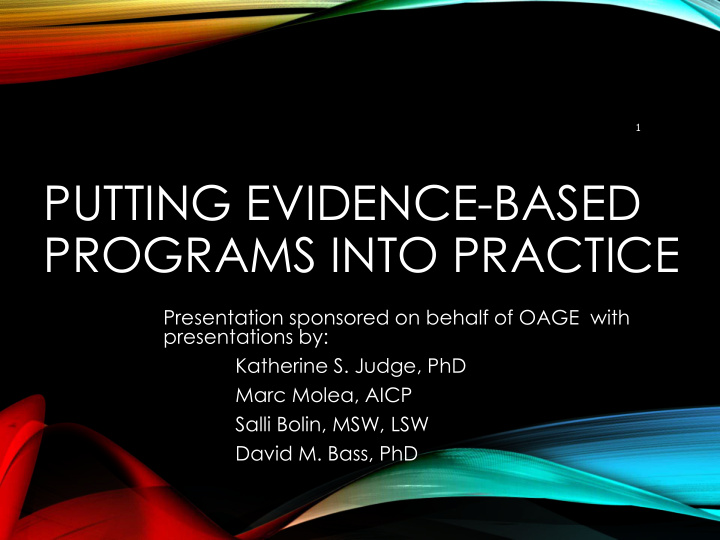



1 PUTTING EVIDENCE-BASED PROGRAMS INTO PRACTICE Presentation sponsored on behalf of OAGE with presentations by: Katherine S. Judge, PhD Marc Molea, AICP Salli Bolin, MSW, LSW David M. Bass, PhD
2 PUTTING EVIDENCE-BASED PROGRAMS INTO PRACTICE Katherine S. Judge PhD, 1, 2, Morgan Watts, BS, 3 & Katelyn Frey, MS 4 Professor of Psychology Director of Adult Development & Aging Doctoral Program Department of Psychology, Cleveland State University 1 Adjunct Senior Research Scientist Center for Research and Education, Benjamin Rose Institute on Aging 2 Doctoral Student, Department of Psychology, Cleveland State University 3 Doctoral Student, Department of Psychology, The University of Akron 4 For more information contact Dr. Judge at k.judge46@csuohio.edu Presented at the O4A conference 11/1/2018
3 CHALLENGES DEVELOPING & IMPLEMENTING EVIDENCE-BASED PROGRAMS (EBPS) • What are the key characteristics of an EBP? • How do you translate research findings from the original research to community settings? • What types of organizations are best suited to develop and implement EBPs? • How do you operationalize and measure success? • How do you staff and train an EPB? • How will the EBP be marketed and financially managed? • What are the benefits in partnering with local researchers?
4 WHAT ARE THE KEY CHARACTERISTICS OF AN EBP? • What are the strengths of the research findings? • Is there demonstrated efficacy using a RCT? • Have there been large-scale effectiveness studies? • Is there evidence of acceptability and feasibility? • Is the EBP compatible with the mission of the parent organization? • Is the EBP ’ s generalizability limited due to concerns about recruitment, attrition, and/or sample bias?
5 HOW DO YOU TRANSLATE RESEARCH FINDINGS FROM THE ORIGINAL RESEARCH TO COMMUNITY SETTINGS? • What are key community characteristics to consider? • Is there a market or source(s) of income to pay for EBP? • Does the EBP match the communities ’ values? • Are there similar programs that will be competing with the EBP? • Are there enough individuals in the community who would need and participate in the EBP?
WHAT TYPES OF ORGANIZATIONS 6 ARE BEST SUITED TO DEVELOP AND IMPLEMENT EBPS? • What organizational features are needed for successful adoption and implementation? • Does your organization have internal champions? • Is there buy-in from other organizational leaders? • Do you have time and resources for education and support for training staff members? • What is the organizational culture towards change and new programs?
7 HOW DO YOU OPERATIONALIZE AND MEASURE SUCCESS? • Does your EBP have a manual of operating procedures and is it user-friendly? • Do you have an efficient record-keeping system? • Are there tools for monitoring the fidelity of the EBP? • Do you have a way to track and evaluate changes from the original program?
8 HOW WILL THE EBP BE MARKETED AND FINANCIALLY MANAGED? • Does your budget cover staffing costs, advertising, space, and other necessary program resources? • Have you evaluated the number of available and interested individuals in the community? • How will the EBP be paid for?
WHAT ARE THE BENEFITS IN 9 PARTNERING WITH LOCAL RESEARCHERS? • How can organizations and university-based researchers mutually benefit from partnering together? • Determining the quality of the research evidence • Translating the program to fit within a community setting • Developing training protocols, on-going fidelity monitoring, and measuring outcomes • How to contact and engage local researchers?
Recommend
More recommend